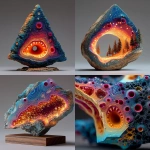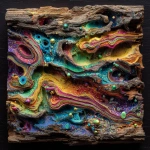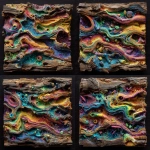Explore the Best AI Image Gallery

Beyond the Brush: How Edge Computing is Transforming Creative Expression
The realm of creativity has always been a playground for innovation, constantly pushing boundaries and exploring new frontiers. In recent years, edge computing has emerged as a transformative force, revolutionizing how artists, designers, and creators interact with their mediums and audiences.
What is Edge Computing?
Edge computing brings computation and data storage closer to the source of data generation, enabling real-time processing and analysis. Imagine a world where your creative tools respond instantly to your every gesture, or where interactive installations adapt seamlessly to the audiences presence. This is the power of edge computing.
Applications in the Creative Industry
- Interactive Installations: Edge computing empowers artists to create immersive and responsive experiences. Sensors can capture audience movement, sounds, or even emotions, triggering dynamic changes in lighting, sound, or visuals, transforming static art into living entities.
- Real-Time Collaborative Design: Architects, designers, and engineers can now collaborate seamlessly on projects, regardless of location. Edge computing facilitates instant feedback loops, allowing teams to iterate designs and make decisions in real time, fostering a more efficient and collaborative workflow.
- Personalized Creative Tools: Imagine AI-powered software that adapts to your unique style and preferences, suggesting creative solutions or generating content based on your input. Edge computing enables personalized creative experiences, empowering creators to push their boundaries further.
- Enhanced Virtual Reality (VR) and Augmented Reality (AR): By processing data locally, edge computing reduces latency in VR and AR applications, creating more immersive and responsive experiences. This opens up exciting possibilities for virtual art galleries, interactive storytelling, and even collaborative design within virtual environments.
Ethical Considerations
As with any powerful technology, edge computing raises important ethical considerations:
- Data Privacy and Security: Processing sensitive data at the edge requires robust security measures to protect user privacy. Clear guidelines and regulations are needed to ensure responsible data handling.
- Algorithmic Bias: AI algorithms used in creative tools can perpetuate existing biases if not carefully designed and monitored. Its crucial to ensure fairness and inclusivity in the development and deployment of edge-powered creative applications.
- Access and Equity: The benefits of edge computing should be accessible to all creators, regardless of their resources or technical expertise. Bridging the digital divide is essential for fostering a more inclusive creative landscape.
Future Trends
The intersection of edge computing and creativity is still in its early stages, but the future holds immense potential:
- Democratization of Creativity: Edge computing will empower individuals with the tools to create and express themselves in new and innovative ways, fostering a more diverse and inclusive creative landscape.
- Hyper-Personalized Experiences: Imagine art installations that react to your emotions or design tools that adapt to your unique style. Edge computing will enable truly personalized creative experiences.
- The Rise of Immersive Storytelling: Edge-powered VR and AR will revolutionize storytelling, allowing audiences to become active participants in immersive narratives.
Conclusion
Edge computing is poised to reshape the creative landscape, empowering artists, designers, and creators with unprecedented tools and possibilities. By embracing its potential while addressing ethical considerations, we can unlock a future where creativity knows no bounds.



](https://images.ai-img.art/thumbnails/150/914cb18c03c97bdba2f290c0ec1573d5792bf399dbad7f484614764eb31f4c2f.webp)







](https://images.ai-img.art/thumbnails/150/98325fa7102e81df81f1dba6df8df52929b4fa41b058192faf3c77cf94513ff7.webp)
](https://images.ai-img.art/thumbnails/150/09314c003088f7174f747fa65105eca599e0842cf69e637ce4c98ebefd3f50ab.webp)

](https://images.ai-img.art/thumbnails/150/3b65287fef447a6ad61bcb18b5b9d03b6f6f74603ae0e058f81f4b91a3e02f36.webp)







](https://images.ai-img.art/thumbnails/150/ac7218edd6198d49ed8d9853a5890595fc4d2a7a11c2e8a7ee8bcfbc7bfe265e.webp)












](https://images.ai-img.art/thumbnails/150/a31f622763ce0ecb2e76a907e566b81cfcc171e8d9b8b393f27681be24b6ca91.webp)

](https://images.ai-img.art/thumbnails/150/769518185300fcbda91b7bbf92b9007bc856379accd52eaf7983f9aec379e88e.webp)






](https://images.ai-img.art/thumbnails/150/7d9de60c58579b921ad140a9e1d752642452d5086b74a27d866e8af04608ed7d.webp)
](https://images.ai-img.art/thumbnails/150/ebc95932b25c17607076ed8d2a4bafc85c3371cf3f2d45c35741505fe3c97de1.webp)



